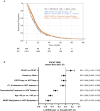Biological and prognostic relevance of epigenetic regulatory genes in high-grade gliomas
- PMID: 39553337
- PMCID: PMC11565242
- DOI: 10.1093/noajnl/vdae169
Biological and prognostic relevance of epigenetic regulatory genes in high-grade gliomas
Abstract
Background: High-grade gliomas (HGGs) are the most aggressive type of gliomas and have the poorest outcomes. Chromatin remodeling (CR) genes have been implicated in multiple oncogenic pathways in numerous cancer types. In gliomagenesis, CR genes have been implicated in regulating the stemness of glioma cells, the tumor microenvironment (TME), and resistance to therapies.
Methods: We performed molecular profiling of 4244 HGGs and evaluated associations of CR mutations with other cancer-related biomarkers, infiltration by immune cells, and immune gene expression. We also evaluated the association between CR mutations and survival in wild-type IDH HGG patients.
Results: Nearly 10% of HGGs carry mutations in CR genes, with a higher prevalence (15%) in HGGs with IDH mutations. Analysis of cooccurrence with other biomarkers revealed that CR-mutated HGGs possess favorable genetic alterations which may have prognostic value. CR-mutated HGGs with wild-type IDH demonstrated colder TME and worse OS overall compared to the CR-wild-type HGGs.
Conclusions: Our study reveals the prognostic effects of CR mutations in HGG and points to several biomarker candidates that could suggest sensitivity to emerging therapeutic strategies.
Keywords: chromatin remodeling; clinical oncology; glioma; molecular oncology.
© The Author(s) 2024. Published by Oxford University Press, the Society for Neuro-Oncology and the European Association of Neuro-Oncology.
Conflict of interest statement
A.S. discloses a conflict of interest as a consultant with Tempus and speakers’ bureau for Novocure; J.X, A.H., and D.S. are employed at Caris Life Sciences; S.D. discloses honoraria from OncoLens, BostonGene and advisory role at Bayer; M.J.D. discloses advisory roles at Bayer, Loxo/Lilly, OnCusp Therapeutics, Orphagen Pharmaceuticals, Pfizer, TD2, Crinetics, and Theralink; S.S. discloses advisory roles at Novocure and Data and Safety Monitoring Board (DSMB) at Bexion; S.K. discloses stock and other ownership Interests in xcures; S.K. discloses honoraria from Jubilant Biosys and Pyramid Biosciences; S.K. discloses advisory roles at Biocept, iCAD, and xcures; S.K. discloses research funding from AIVITA Biomedical, Inc., Bayer, Biocept, Blue Earth Diagnostics, Boehringer Ingelheim, Boston Biomedical, Caris MPI, CNS pharmaceuticals, EpicentRx, Lilly, Oblato, and Orbus therapeutics; D.M.A. discloses stock and other ownership Interests in Diverse Biotech and MAIA Biotechnology; D.M.A. discloses advisory roles at Jackson Laboratory for Genomic Medicine and MAIA Biotechnology; D.M.A discloses patents, royalties, and other Intellectual Property - Methods for predicting tumor response to immunotherapy, U.S. Provisional application no. 62/787,508 filed January 2, 2019 Methods for predicting tumor response to immunotherapy, U.S. Provisional application no. 62/620,577 filed January 23, 2018; A.L.S. discloses stock and other ownership Interests in Novocure; A.L.S. discloses honoraria from Cardinal Health, Curio Science, and Gerson Lehrman Group; A.L.S. discloses advisory roles at Abbvie, Amgen, Athenex, Bayer, Exelixis, Merck, and Novocure; A.L.S. discloses speaker’s bureau at Abbvie; Bayer; Bristol-Myers Squibb; Exelixis; Merck; Novocure; Prime Oncology; A.L.S. discloses research funding from Bristol-Myers Squibb, Exelixis, Kura Oncology, Novocure, and Oncoceutics; A.L.S. discloses travel and accommodation expenses from American Association of Neurological Surgeons, Bristol-Myers Squibb, Novocure, and Xcenda; M.J.G. discloses advisory role at Biocept; M.J.G. discloses research funding from cns pharmaceuticals, Denovo Biopharma, European Organization for Research and Treatment of Cancer (EORTC), Five Prime Therapeutics, Genentech, ImmunoCellular Therapeutics, Ono Pharmaceutical, RTOG, Sunovion, Triphase Accelerator Corp, and Vascular Biogenics; The rest of the authors have no conflicts of interest to disclose.
Figures





References
-
- Centore RC, Sandoval GJ, Soares LMM, Kadoch C, Chan HM.. Mammalian SWI/SNF chromatin remodeling complexes: Emerging mechanisms and therapeutic strategies. Trends Genet. 2020;36(12):936–950. - PubMed
-
- Ribeiro-Silva C, Vermeulen W, Lans H.. SWI/SNF: Complex complexes in genome stability and cancer. DNA Repair (Amst). 2019;77(May):87–95. - PubMed
LinkOut - more resources
Full Text Sources
